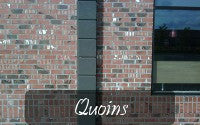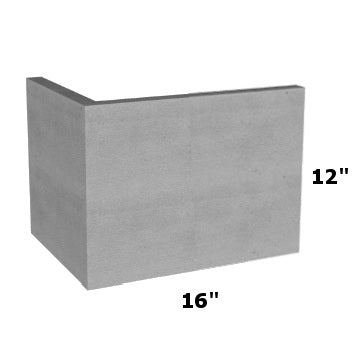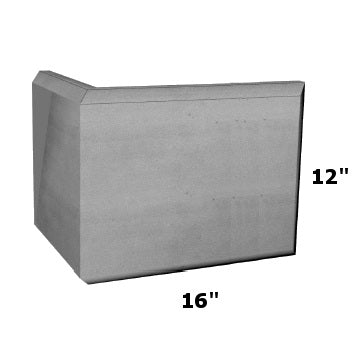Corner Quoins
Processing time: 1-5 Business days
Shipping time: 3-9 Business days
Shipping and processing times are typical estimates, not guarantees.

- Free Shipping direct to your jobsite or home
- Add character to your walls with imitation stone corner quoins
- Can be installed during construction, or after as a renovation
- Painted any color of your choosing after installation
- Shipped direct to your jobsite or home
- How to build staggered corner quoins
- View more Exterior Window Trim Ideas
Quoins accent the corners of your house, giving them the illusion of sturdiness and elegance. "Stucco Quoins" are a great substitute for otherwise heavy and expensive pre-cast, stone and brick quoins. Quoins come in a variety of styles to suit your taste. They may be straight edged (001/002) or beveled (005/006), and may be installed joined together or spaced apart to look like high end concrete quoins.
Installing Quoins
Quoins can be installed either during the initial construction phase, or added afterwards. They make a significant change in the appearance of a home, making it one of the simplest and most cost-effective exterior renovations available. The light-weight of the styrofoam-core quoins means that no structural reinforcing is required, and that they can be added with simple construction adhesive. Caulking is recommended around the joints once the quoins are installed, and you can paint them any colour of your choosing with any exterior masonry paint.
Faux Quoins
Quoins are very rarely made of real stone - most quoins installed in modern projects are fake quoins similar to the ones we sell - with a styrofoam core and a precast cement coating, made to look like stone. These are not only less expensive, but also more cost-effective when it comes to labor and installation.
Stone Quoins are also sometimes artificially made from a cement mold, and can weigh 50-60 pounds each. If installed during construction they can be structurally integrated into a wall for support, but installation during a renovation is often invasive and expensive. Decoramould faux quoins look like stone quoins, but with a weight of just 5-10 pounds each, can be simply adhered to a wall with cement adhesive. Quick, and cost effective.
Example:
decoramould.com/windows-quoins-wall-band.html
Videos:
Idea: Corner quoins
The homeowner was obviously a fan of windows, and lots of light. They made ample use of corner quoins on their multiple corners with a unique design. In addition, the architect had the good sense to install a molding along the break between the first and second floor, which will go a long way in hiding any cracks which might occur at this weaker portion of the house. A cornice is used between the wall and soffit to sort of "cap off" the quoin corners.
Exterior trim in this photo...
Decoramould is a stucco quoins supplier for exterior home renovation, retrofits and alterations throughout the U.S.A. and Canada. Customers can buy corner quoins online, and have their exterior quoins purchase shipped directly to them.
Our stucco quoins look like high end concrete quoins, but weigh only a fraction as much - and often cost only a fraction as much as well. They can be installed during the initial construction of a home or building, or added on as decorative quoins after construction. Installation is as easy as adhering them to the wall surface, for more information see installation instructions.
Are Stucco Quoins a 'Worst Home design' mistake?
I recently read an article on supposed “worst design mistakes” and surprisingly, styrofoam-core quoins made the list! Curiously, I read through the rest of the article which actually had good information in it. But my original gripe stands.
Stucco Quoins were design mistakes edited out of our video. On the outside corners of stucco houses, it’s typical to see a Georgian style detail of what looks like stone blocks or bricks, usually alternating in sizes. Stone quoins are typically part of a Georgian design where the exterior is totally stone or brick, with the quoins integrated.But there should never be quoins on a stucco house, and we see many of these on McMansions. Need we say more? Modern quoins merely represent stone, yet they’re made of polystyrene. If you’re going to build a home, strive for integrity in both your design and your building materials. There is nothing wrong with stucco, but quoins are traditionally not found on Mediterranean-style stucco houses.
And for the record, we think the fake wood quoins, painted to look like stone on many early American buildings are quaint. At least they’re trying to fit in with Georgian design, not trying to meld two wildly disparate design styles for the sake of tarting things up.
Source: http://www.design2share.com/qa/2007/11/15/what-are-the-worst-home-design-mistakes.html
The first thing I’ll say is that I agree with putting quoins only when they belong – though often overlooked, the style of a home should partially dictate what architectural mouldings and features are used to enhance the home. Of course, the home owner’s personal taste need also play a role. That said, not too many Mediterranean style homes are seen up here in Toronto.
But to say that quoins never belong on stucco? Overlooking the fact that there are two “kinds” of stucco (cement-stucco and EIFS) and that EIFS is composed of the self-same material, stucco quoins not only serve an aesthetic role but also a protective one. The corners of buildings (including homes) are often one of the more susceptible places of a wall – whether there is a walkway or a path leading to the backyard, when people turn corners there’s a higher risk of accidentally hitting the wall with objects than when they’re walking straight.
Repairing a stucco wall is never an easy feat, colors never quite match up and a patch is plainly obvious on what should be a monolithic wall. I have personally seen many projects where the entire of the two walls forming the corner had to be redone because of a 2″x2″ hole punched out of a corner from (for example) a wheelbarrow turning a corner.
In this respect, styrofoam quoins are able to act as a “sacrificial” layer. While re-coating 2 walls can cost anywhere from $2000-$5000, replacing a single damaged styrofoam quoin will cost $30 in materials and can actually be done by the home owner.
Authenticity
The only real substitute for “authentic” stone quoins is – stone quoins. Veneer stones are one option, but the cost and reinforcing required to adhere the higher weight concrete materials ends up being cost prohibitive in most cases. Why would you need real stone anyways? Quoins are no longer used to structurally reinforce the corners of buildings, as was “authentic” in the past. In modern construction, quoins are purely cosmetic regardless of the material they’re made of. Does it not make sense then to use a material that is light weight, easy to work with, and has the same look as stone?

Rotting Wood Quoin
Wood quoins are a poor, poor substitute for styrofoam quoins. Actually, wood used as exterior trim where it is exposed to high levels of moisture and/or freeze-thaw cycles is a horrible choice in general. Being organic, wood quoins are susceptible to moisture absorption, leading to rot and mold. While this isn’t particularly a health hazard on the exterior of the home, it is nonetheless unattractive and an unwanted quality in buildings. Wood is a food source for termites, and if wooden quoins are placed too low to the ground, they provide a great snack for hungry termites, which can then migrate into walls.
Styrofoam on the other hand, is not a hydrophilic material. While it is not impervious to moisture, the degree to which it is affected is negligible compared to wood. This low-moisture absorption is particularly important in parts of the country (both in the U.S. and Canada) where there are freeze-thaw cycles. When water freezes, it forms a crystalline network that takes up more space than in the liquid form. If you have a building material that is saturated with water, and freezes, the effect is the material (such as wood) being pushed apart from the inside due to the pressure of the water crystallizing. A few times shouldn’t cause any huge problems, but when it happens hundreds of times over year and years, it will cause the material to disintegrate.
Styrofoam is also inorganic, that is – it doesn’t act as a food source for termites and other pests. This decreases the odds of unwanted invertebrates taking up habitation in your home. Additionally, without a supply of nutrients, mold and bacteria are unable to survive and thrive.
So, What’s the Verdict?
As mentioned earlier in the article, quoins are not appropriate for every situation. Even having a vested interest in selling them to clients, there have been situations when I recommended against their use because it would not have been appropriate for the building. The overall aesthetics need to be taken into consideration.
While quoins are purely aesthetic, they can play a protective role and save you a massive headache (and repair bill) should something happen to the corners of your walls. Replacing a single damaged quoin is child’s play compared to re-patching entire walls and trying to color match stucco that has been on the wall for 5 or more years.
And finally, I can’t agree in any way as to the argument that stucco quoins are somehow “fake” or “inauthentic”. Quoins by nature in the 21st century are inauthentic, and from a distance, stucco quoins look a lot more like the “real thing” than wood quoins due to the cementitious coating.
I’d love to hear your thoughts and opinions on the topic, please feel free to leave a message.




